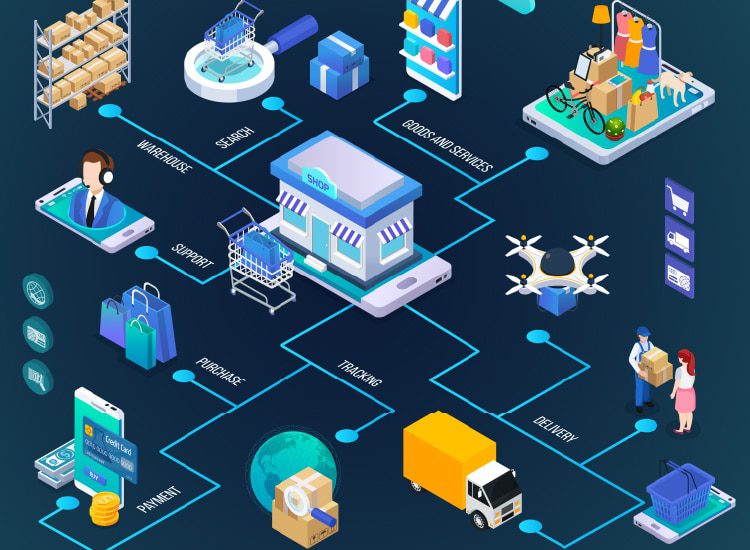What is a smart supply chain? Let it transform your business

Smart supply chains, embodied in Supply Chain 4.0, represent the next step in supply chain management. The goal is to create smart and agile networks by prioritising real-time data, transparency, and connectivity among suppliers, manufacturers, distributors, and customers. John Young, from EU Automation, explores the potential of future technologies such as artificial intelligence and digital twins. He discusses the definition of a smart supply chain and how these innovations can improve process efficiency while opening up new possibilities.
Supply chain disruptions, once sporadic and localised, have surged in frequency and severity in recent years. Manufacturers are facing increasingly frequent and impactful challenges from natural disasters, geopolitical events, trade tensions, and health crises. These challenges have become more complex to overcome. Many experts are already referring to the 2020s as “the most disruptive decade in supply chain history.”
The intricate web of global supply chains implies that upheaval in one locale sends ripples reverberating throughout the entire system. Longer and more complex supply chains only increase the challenge of responding swiftly to disruptions or changing market demands.
Forefront manufacturers are presently questioning prevailing paradigms and reevaluating their supply chain approaches. Their aim is to become more resilient and drive down costs. This next evolution of supply chain management, characterised by the use of advanced technologies, is called Supply Chain 4.0.
Smart supply chain definition:
What is a smart supply chain and supply chain 4.0?
Smart supply chains, like Supply Chain 4.0, are the future of digital supply chains. They are built on analytical demand planning and sales and operations planning (S&OP)2.
Most experts agree that Supply Chain 4.0 incorporates certain key technologies for the evolution of supply chain management. These encompass, albeit are not confined to:
- artificial intelligence (AI)
- enhanced reality / simulated reality (ER / SR)
- autonomous systems and robotics
- blockchain
- cloud computing
- cybersecurity
- data analytics
- digital twins
- Internet of Things (IoT).
While these technologies are not technically new, recent advances have enabled an array of new applications.
Supply Chain 4.0, like other areas of smart manufacturing, requires access to real-time data. So, while the technologies that underpin Supply Chain 4.0 may be digital, physical assets are equally as important. These include connected machinery, RFID tags, smart gadgets, and sensors.
This extends to warehouse automation solutions like sorting and conveyor systems, automatic storage and retrieval systems (ASRS). As well as, automated guided vehicles (AGVs) and autonomous mobile robots (AMRs). These tangible resources intertwine with the digital framework, linking the virtual and material aspects of the supply chain.
Hence, Supply Chain 4.0 is intricately connected to Industry 4.0. Both concepts aim to use new technology to improve efficiency, connection, and agility in manufacturing and supply chain processes. Supply Chain 4.0 extends these principles beyond the factory floor and across the entire value chain.
It strives to build intelligent and responsive networks by focusing on real-time data, visibility, and connectivity among suppliers, manufacturers, distributors, and customers.
So, now that we have covered the theory, in practice, how can smart supply chains such as Supply Chain 4.0 work?
Supply chain transformation: What are the advantages of smart supply networks?
Demand forecasting, route optimisation and inventory control are central to effective supply chain management. These interconnected processes help make supply networks more efficient, agile and customer-focused. However, numerous businesses persist in employing traditional approaches that struggle to accommodate market fluctuations and shifts in customer preferences.
Therefore, route planners typically face ongoing challenges that demand regular and rapid course corrections. Furthermore, traditional inventory management frequently leads to either excess of or a shortage of goods, both of which increase expenses and waste.
Smart supply chains harness real-time data, advanced analytics, and automation by infusing demand forecasting, route optimisation, and inventory management. This integration allows for a more adaptive, efficient and responsive network.
What is demand forecasting?
Demand forecasting is the technique of predicting future demand for goods or services. It has historically relied on past sales figures, statistical models, and market trends.
However, this method lacks adaptability and struggles to respond to abrupt variations in consumer demand. This results in either overstocking or understocking. Overstocking increases capital and storage costs, but a lack of stock can lead to dissatisfied customers and lost sales.
A smart supply chain model uses advanced analytics andAI algorithms to analyze large datasets. These algorithms consider client behaviour, social media, and market trends. By recognizing trends, they can make more accurate forecasts. Real-time visibility enables you to revise market demand forecasts as conditions change.
What is route optimisation?
Route optimisation involves identifying the most efficient route for moving products from production to distribution to end-users. However, it is vital to remember that historical data and static plans can quickly become obsolete in unanticipated circumstances. Customers’ expectations for same-day or next-day deliveries intensify the situation. To remain competitive, manufacturers must ensure that delivery options are quick and flexible. Smart supply chains could introduce dynamic changes. This ensures that routes remain optimal even while dealing with continually changing factors.
Real-time tracking allows logistics managers to monitor shipments minute by minute. This is achievable with IoT devices, GPS, and sophisticated RFID tags. This allows them to continue optimising transportation routes based on current conditions.
Route planners can also use predictive analytics to anticipate future impediments and make informed decisions that optimise networks and save delays. This strategy not only ensures timely delivery, but also helps with strategic planning. Identifying trends and patterns that influence a company’s long-term supply chain strategy accomplishes this goal.
What is inventory management?
Inventory management is the systematic monitoring of stock levels to ensure maximum availability for fulfillment while lowering storage costs.
Typical methods of tracking and maintaining stock levels frequently involve periodic stock checks and human reordering. However, this technique struggles to strike the right balance between having enough stock and having too much or too little. The lack of dynamic datasets also impedes traditional inventory management.
Recently, effective inventory management has grown more difficult. This issue is caused by a variety of factors:
- The rise of e-commerce
- The presence of entrenched information silos
- Companies carrying broader product portfolios.
Smart supply chains combine smart automation and data-driven decision-making to simplify inventory management and maintain correct stock levels. The RFID tags on each item in the inventory enable seamless connection with the centralized system. This allows for real-time tracking and offers quick updates. As a result, inventory managers have accurate and up-to-date information, allowing them to respond swiftly to any changes.
Predictive analytics turns inventory management into a strategic tool rather than a reactive one, detecting patterns that allow inventory managers to optimize stock levels. Using automated reordering systems powered by AI and machine learning decreases the possibility of errors and ensures timely stock replacement.
Making these improvements can result in significant cost reductions in transportation and warehousing, administration, and stockholding. These enhancements can result in up to 30% decreased transportation and warehousing expenses. In addition, administrative costs will be reduced by 50% to 80%, with stockholding reduced by up to 75%. Furthermore, these adjustments can significantly improve company agility [3].
Linking industry 4.0 with supply chain 4.0
Undoubtedly, Supply Chain 4.0 heralds a new era of resilience and adaptability, owed to its cutting-edge analytics and instantaneous visibility capabilities.Therefore, supply chain 4.0 will give companies a strong advantage in a highly competitive market.
However, these benefits can link back into the manufacturing arena. They can help minimise downtime by seamlessly integrating smart manufacturing with smart supply chains.
The rising adoption of predictive analytics, IoT sensors and interconnected systems is providing manufacturers with unique real-time insights into machinery health and performance. With this foresight in hand, you can enact data-informed decisions and implement predictive maintenance strategies, bolstering operational efficiency and preempting potential disruptions. This will help you avoid sudden, costly machine downtime.
When machine downtime does strike, smart supply chains will prove crucial in rapidly addressing issues and restoring operations. With better visibility and openness, a digital supply chain’s interconnected nature makes it easy to find faulty parts or systems quickly. Smart supply chains are essential for a streamlined process for sourcing replacement parts or equipment. Ultimately, this aids in minimising downtime in manufacturing, ensuring seamless operation of assembly lines and uninterrupted productivity.
Smart supply chain transformation requires trusted partners
Smart supply chains, driving supply chain transformation, have the potential to reform manufacturing. This is accomplished by leveraging sophisticated automation, instantaneous data analytics, and AI systems.
The advantages of such an ecosystem allow manufacturers to stay afloat despite rising instability and supply chain disruptions. It could also “close the loop” by connecting smart supply chains to smart manufacturing processes. This can help to reduce downtime.
Successful adoption of Supply Chain 4.0 is not simply a matter of adopting the right technologies. It will also need people to work together and form strategic relationships. Global suppliers like EU Automation stand as dependable partners, offering invaluable support as logistics and technology suppliers for manufacturers. They help to build a networked ecosystem where information flows smoothly and spare parts are easy to find at the right time and place.
Companies can build a resilient operation that is ready to meet the supply chain demands of the future. This is accomplished by integrating cutting-edge technologies, nurturing collaboration, and embracing a progressive mindset.
Editor notes
- https://www.cushmanwakefield.com/en/insights/the-most-disruptive-decade-in-supply-chain-history-six-key-trends-to-watch
- https://www.mckinsey.com/capabilities/operations/our-insights/supply-chain-40–the-next-generation-digital-supply-chain
- Mckinsey, ibid.





